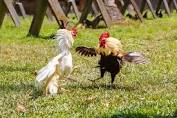Polba is a chicken native to Poland.
It was developed by crossing the Polish Green-legged Partridge with the American Plymouth Rock Cock.
Polbar is an autocoital race
which means that if the chick is a rooster or a hen,
we can recognize its birth by the visible characteristic of the color of
Table of Contents
feature Polba
The Polbar is a dual-purpose chicken breed valued for its excellent meat and egg flavor.
Its unique features in backyard farming are its high freedom of access to food, its high survivability and its resistance.
In addition to the aforementioned advantages, it is also important that they have unique genes,
thus they are an important gene pool and material for Polish poultry science research.
They show general disease resistance and good performance in different environmental conditions.

Polba different colors
Polar bears have only one color.
Young chickens are creamy white and adults are gray-brown.
It has a single crown, red lobes and gray-yellow legs.
Porba chickens are also excellent producers of cream eggs
(160 eggs per year), but they do not tend to hatch the eggs of the American Plymouth Rock.
Polba history
The Polba is a Polish native chicken breed that has been crossed between
Greenleg Partridge hens and Plymouth Rock roosters between 1946 and 1953.
The Laura Kaufmann Small Animal and Poultry Research Station at Lublin University of Life Sciences
Poland has the only Polba chicken population in the world.
From a population of about 1,000 birds, purebreds have been preserved for more than 50 generations.
race car sex PolbaR
Self-testing is the fastest way to determine gender
of chicken and characterized by high precision,
provided that the maternal and paternal portions are properly matched.
In the case of the Borba breed, the hen can be distinguished from the middle rooster
longest black streak from the first day of hatching.
Determining the sex of day-old chicks from other breeds is very difficult and sometimes impossible.
Additional information
The Polbar chicken breed is being conserved and researched under
Polish Genetic Resource Conservation Program with the main objective of protecting individuals
population and protect them from extinction,
as well as consolidating and preserving their unique production
functional and phenotypic characteristics (eg, eggs and Flavor value. of edible meat),
disease resistance and its behavioral characteristics.
These birds are conserved through an in situ method that includes
protection of certain groups of living animals in their natural environment, that is
on small farms in the countryside.
The goal of the program is that within each flock of protected hens,
the genetic balance is maintained at a constant level and the specific
characteristic of bisexual birds is preserved.
